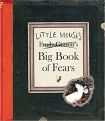Little Mouse's Big Book of Fears by Emily Gravett
| Little Mouse's Big Book of Fears by Emily Gravett | |
|
| |
| Category: For Sharing | |
| Reviewer: Magda Healey | |
| Summary: It's funny, it's amusing, it's brilliantly done and any teacher at a primary school should get one (or a set) to use for art, drama, literacy and the like. It can help to talk about fears, but it can also sensitise them: after all, who'd like to be a mouse? | |
| Buy? Maybe | Borrow? Maybe |
| Pages: 32 | Date: August 2007 |
| Publisher: Macmillan Children's Books | |
| External links: Author's website | |
| ISBN: 978-1405089487 | |
|
| |
I liked the Little Mouse's Big Book of Fears. It's made up of confident, mature, original artwork which uses a combination of colour and black and white drawings in a variety of media (charcoal, pencil, ink, pastel and possibly others) as well as great collages, and the whole book is also part of the execution, what with mouse-bitten holes and torn pages, and nibbled edges. A board book as a mini-installation perhaps?
It juggles and plays with existing texts and genres, from the nursery rhyme to a proverb to a newspaper news item to advertising copy - in fact it's so post-modernistically cool it almost gets too much. The verbal and visual jokes are intelligent but accessible, and it's interesting to the degree that my still not-reading 6 year old spent close on 2 hours poring over it.
And finally, it's a great take on self-help manuals, created in a book-in-a-book form.
Originally Emily Garett's Big Book of Fears it starts with an earnest preamble stuck on the frontispiece, advertising it as the essential book to overcome your fears. Each page is headed with the name of a phobia - from real like hydrophobia to invented like whereamiphobia - and instruction to use the blank space below to record your fears. Alas, the book we get has been already well used by a little rodent to record her fears, and as we all know mice are afraid of... well, pretty much everything. Each page is a mini-masterpiece, where in scribble and collage, tear-out and drawing the mousey fears are indeed recorded. There is even a hilarious mouse-shaped map of The Isle of Fright to explore!
It's funny, it's amusing, it's brilliantly done, it has masses of intricate detail and even a punch line (or a twist in a tale, as far as there is a tale). It's wonderfully designed and carefully produced.
I think anybody working with primary school age children could make a good use out of this book. I can envisage several applications for the Little Mouse's Big Book of Fears, and for all these purposes it would be good for a range of ages, I would say from about 6 onwards up to even younger teenagers.
Firstly, it could be used as a great example of child-accessible artwork which shows how different media and materials can be combined to produce a meaningful, original whole. Secondly it can be used to explore the post-modernists play with texts (without using the Big Bad Words) as the "Three Blind Mice" get retold as a news item and "Hickory Dickory Dock" is used as a inspiration for a riot of a gritty, dynamic drawing. Thirdly, it is ideal as an example of an empathetic put-yourself-in-sombeody's shoes exercise that (honestly!) borders on method acting (what are mice scared of? how would one see the word? how would it see a bird? or a cat? why is a picture of a cat behind a flap? etc).
Would I recommend it for "normal" home reading/usage? To be honest, I don't know. It depends on how you interact with your children over books, how much money you have to spend on books and how interested your child is in things to do with art. A normal younger primary schooled aged child would probably be easily able to identify with the mouse (mice are small and thus, in some way, resemble small children), and might even share (or remember having had when younger) some of the fears while the fold-out map allows for exploration of bodily symptoms of being scared, and may even prompt a wee fight-flight lecture in biology.
I am not certain if a child that suffers from high general anxiety or a particular phobia would enjoy (and/or benefit) from that book. If used in a therapeutic manner, it devotes so much attention to the fears that it might result in increasing them rather than reducing (a fear faced might be a fear halved but a fear imagined, described and drawn in detail won't necessarily get smaller). For those who find it hard to discuss their anxieties, it might provide a projection tool - it'd much easier to talk about mouse's fears than one's own! On the other hand, if I was very scared I would not particularly enjoy identifying with a mouse, of all things: I think it would have made me feel worse. It might be a personal thing, though.
Nevertheless, Little Mouse's Big Book of Fears is definitely worth a look, and if you work with children, worth buying.
Thanks to the publisher for sending this to the Bookbag!
Another picture book with innovative artwork is There Was An Old Lady Who Swallowed A Fly, while this deceptively simple classic allows a true insight into the toddler's scary psyche. No Babysitters Allowed by Amber Stewart and Laura Rankin is also well worth a look.
Please share on: ![]() Facebook,
Facebook, ![]() Twitter and
Twitter and
![]() Instagram
Instagram
![]() You can read more book reviews or buy Little Mouse's Big Book of Fears by Emily Gravett at Amazon.co.uk Amazon currently charges £2.99 for standard delivery for orders under £20, over which delivery is free. (Paid link)
You can read more book reviews or buy Little Mouse's Big Book of Fears by Emily Gravett at Amazon.co.uk Amazon currently charges £2.99 for standard delivery for orders under £20, over which delivery is free. (Paid link)
![]() You can read more book reviews or buy Little Mouse's Big Book of Fears by Emily Gravett at Amazon.com. (Paid link)
You can read more book reviews or buy Little Mouse's Big Book of Fears by Emily Gravett at Amazon.com. (Paid link)
Comments
Like to comment on this review?
Just send us an email and we'll put the best up on the site.


